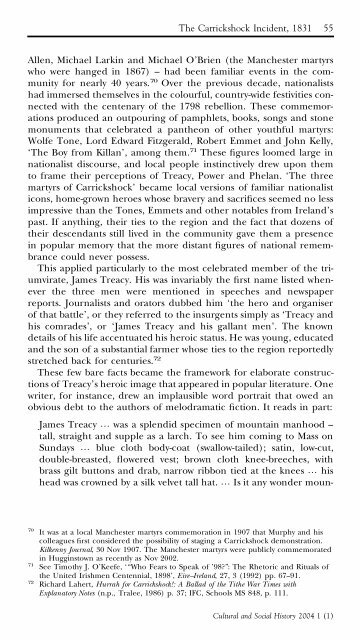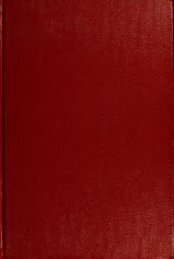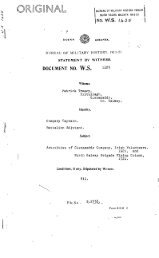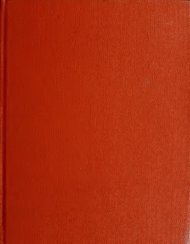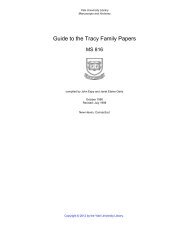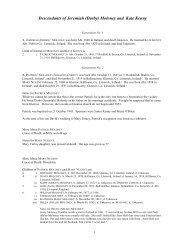The Carrickshock Incident, 1831: Social Memory and an Irish cause ...
The Carrickshock Incident, 1831: Social Memory and an Irish cause ...
The Carrickshock Incident, 1831: Social Memory and an Irish cause ...
You also want an ePaper? Increase the reach of your titles
YUMPU automatically turns print PDFs into web optimized ePapers that Google loves.
<strong>The</strong> <strong>Carrickshock</strong> <strong>Incident</strong>, <strong>1831</strong> 55<br />
Allen, Michael Larkin <strong><strong>an</strong>d</strong> Michael O’Brien (the M<strong>an</strong>chester martyrs<br />
who were h<strong>an</strong>ged in 1867) – had been familiar events in the community<br />
for nearly 40 years. 70 Over the previous decade, nationalists<br />
had immersed themselves in the colourful, country-wide festivities connected<br />
with the centenary of the 1798 rebellion. <strong>The</strong>se commemorations<br />
produced <strong>an</strong> outpouring of pamphlets, books, songs <strong><strong>an</strong>d</strong> stone<br />
monuments that celebrated a p<strong>an</strong>theon of other youthful martyrs:<br />
Wolfe Tone, Lord Edward Fitzgerald, Robert Emmet <strong><strong>an</strong>d</strong> John Kelly,<br />
‘<strong>The</strong> Boy from Kill<strong>an</strong>’, among them. 71 <strong>The</strong>se gures loomed large in<br />
nationalist discourse, <strong><strong>an</strong>d</strong> local people instinctively drew upon them<br />
to frame their perceptions of Treacy, Power <strong><strong>an</strong>d</strong> Phel<strong>an</strong>. ‘<strong>The</strong> three<br />
martyrs of <strong>Carrickshock</strong>’ became local versions of familiar nationalist<br />
icons, home-grown heroes whose bravery <strong><strong>an</strong>d</strong> sacri ces seemed no less<br />
impressive th<strong>an</strong> the Tones, Emmets <strong><strong>an</strong>d</strong> other notables from Irel<strong><strong>an</strong>d</strong>’s<br />
past. If <strong>an</strong>ything, their ties to the region <strong><strong>an</strong>d</strong> the fact that dozens of<br />
their descend<strong>an</strong>ts still lived in the community gave them a presence<br />
in popular memory that the more dist<strong>an</strong>t gures of national remembr<strong>an</strong>ce<br />
could never possess.<br />
This applied particularly to the most celebrated member of the triumvirate,<br />
James Treacy. His was invariably the rst name listed whenever<br />
the three men were mentioned in speeches <strong><strong>an</strong>d</strong> newspaper<br />
reports. Journalists <strong><strong>an</strong>d</strong> orators dubbed him ‘the hero <strong><strong>an</strong>d</strong> org<strong>an</strong>iser<br />
of that battle’, or they referred to the insurgents simply as ‘Treacy <strong><strong>an</strong>d</strong><br />
his comrades’, or ‘James Treacy <strong><strong>an</strong>d</strong> his gall<strong>an</strong>t men’. <strong>The</strong> known<br />
details of his life accentuated his heroic status. He was young, educated<br />
<strong><strong>an</strong>d</strong> the son of a subst<strong>an</strong>tial farmer whose ties to the region reportedly<br />
stretched back for centuries. 72<br />
<strong>The</strong>se few bare facts became the framework for elaborate constructions<br />
of Treacy’s heroic image that appeared in popular literature. One<br />
writer, for inst<strong>an</strong>ce, drew <strong>an</strong> implausible word portrait that owed <strong>an</strong><br />
obvious debt to the authors of melodramatic ction. It reads in part:<br />
James Treacy % was a splendid specimen of mountain m<strong>an</strong>hood –<br />
tall, straight <strong><strong>an</strong>d</strong> supple as a larch. To see him coming to Mass on<br />
Sundays % blue cloth body-coat (swallow-tailed); satin, low-cut,<br />
double-breasted, owered vest; brown cloth knee-breeches, with<br />
brass gilt buttons <strong><strong>an</strong>d</strong> drab, narrow ribbon tied at the knees % his<br />
head was crowned by a silk velvet tall hat. % Is it <strong>an</strong>y wonder moun-<br />
70 It was at a local M<strong>an</strong>chester martyrs commemoration in 1907 that Murphy <strong><strong>an</strong>d</strong> his<br />
colleagues rst considered the possibility of staging a <strong>Carrickshock</strong> demonstration.<br />
Kilkenny Journal, 30 Nov 1907. <strong>The</strong> M<strong>an</strong>chester martyrs were publicly commemorated<br />
in Hugginstown as recently as Nov 2002.<br />
71 See Timothy J. O’Keefe, ‘“Who Fears to Speak of ’98?”: <strong>The</strong> Rhetoric <strong><strong>an</strong>d</strong> Rituals of<br />
the United <strong>Irish</strong>men Centennial, 1898’, Eire–Irel<strong><strong>an</strong>d</strong>, 27, 3 (1992) pp. 67–91.<br />
72 Richard Lahert, Hurrah for <strong>Carrickshock</strong>!: A Ballad of the Tithe War Times with<br />
Expl<strong>an</strong>atory Notes (n.p., Tralee, 1986) p. 37; IFC, Schools MS 848, p. 111.<br />
Cultural <strong><strong>an</strong>d</strong> <strong>Social</strong> History 2004 1 (1)


